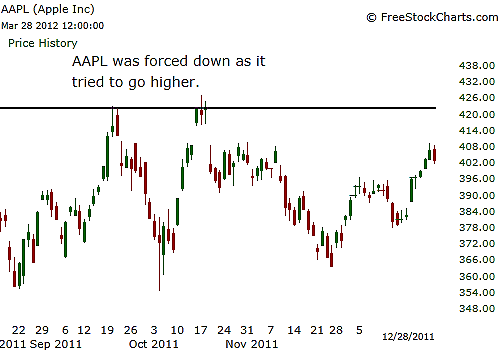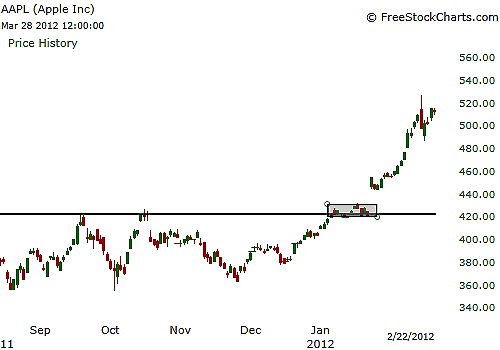
HOT TOPICS LIST
- MACD
- Fibonacci
- RSI
- Gann
- ADXR
- Stochastics
- Volume
- Triangles
- Futures
- Cycles
- Volatility
- ZIGZAG
- MESA
- Retracement
- Aroon
INDICATORS LIST
LIST OF TOPICS
PRINT THIS ARTICLE
by Billy Williams
Traders fall victim to fakeouts caused by floor traders who see where the buy & sell orders are on the exchanges, but by making a few adjustments, you can turn the tables and profit.
Position: Hold
Billy Williams
Billy Williams has been trading the markets for 27 years, specializing in momentum trading with stocks and options.
PRINT THIS ARTICLE
STRATEGIES
How To Avoid Fakeouts
03/29/12 09:47:43 AMby Billy Williams
Traders fall victim to fakeouts caused by floor traders who see where the buy & sell orders are on the exchanges, but by making a few adjustments, you can turn the tables and profit.
Position: Hold
| There it is, up there on a price chart -- a stock that you've been following for weeks or months that has been trading in a tight first stage base and whose price action is tightening up like a coiled spring and looks like it's going to break out. Then, just as you're ready to put on a position, price pulls back and ruins your chance of an entry. "It's okay," you say to yourself, "I'll just buy into the move as it trades up through its former price high." But as price trades through that high, it starts to gyrate and goes through a series of fits and starts before it snaps back to hit you in the face as it triggers your stop order. Then, just as it hits your stop, it rockets back up to its former high and takes off even higher with the force of a cruise missile on its way to some destination that is known only to price itself. (See Figure 1.) Congratulations, you're a victim of a fakeout. |

|
| FIGURE 1: AAPL. In late 2011, Apple Inc. tried to trade higher but was forced lower, possibly by price manipulation from the floor traders who knew that private traders would try to buy at the new high and then sold into that accumulation, resulting in price weakness and price declines. |
| Graphic provided by: www.freestockcharts.com. |
| |
| Fakeouts are as common to trading since the first floor traders first donned trading jackets and stepped into the sea of traders armed only with their buy and sell slips. The competitive advantage that they have is that they are close to the action and can determine where the buy orders are as well as the stop-loss orders. Not all are able to separate themselves from the noise, but the veterans on the floor of these exchanges didn't get rich or become veterans by following the herd. |

|
| FIGURE 2: AAPL. In early 2012, AAPL again tried to trade higher but even then it experienced price contraction as traders tried to wrestle control of the trend away from the floor traders who were causing price to trade in a tight range. Eventually, they gave in to the bulls and let them take the price higher. |
| Graphic provided by: www.freestockcharts.com. |
| |
| They have survived and thrived by being more clever than the rest and by knowing where the critical price zones are, where the off-the-floor traders have placed pockets of orders as the market forms a recognizable trade setup or chart pattern. You and I may have the benefit of being away from the noise of the floor, but that doesn't mean that the floor traders can't spot a first stage base pattern or a pullback in the trend. Knowing that off-the-floor traders are looking to trade into an established trend or setup, floor traders look to exploit this fact by forcing price in the opposite direction at the perfect time in order to unnerve the private traders who are relying on what their computers tell them and force them out of the trade. |
| When that happens, floor traders can see and hear when the pocket of orders are being filled and take the other side of the trade and force price to resume its original move, resulting in another round of profits. This back-and-forth trading happens every day, and the best way to counter being a victim of a fakeout is to trade small-cap stocks or stocks that have fundamental and technical potential but are not as widely followed as some large-cap stocks such as Google or Apple Inc. While small-cap stocks can be prone to the same phenomenon, the fact is that they are not as closely watched or as liquid to the floor trader and, therefore, are ignored in large part. (See Figure 2.) |
| More important, if the stock is selected correctly, then it is likely a candidate for a large institutional trader is looking to take a position and it is someone against whom floor traders would not want to trade, as their own buying power pales in comparison to the massive financial power that most institutional traders possess. If floor traders were caught on the opposite side as an institution was taking a position, it would be the same as a person stepping in front of an ongoing freight train. So look for stocks with a low float, small capitalization, and low number of outstanding shares and you can avoid being a victim of a fakeout and the games that floor traders play at our expense. |
Billy Williams has been trading the markets for 27 years, specializing in momentum trading with stocks and options.
| Company: | StockOptionSystem.com |
| E-mail address: | stockoptionsystem.com@gmail.com |
Traders' Resource Links | |
| StockOptionSystem.com has not added any product or service information to TRADERS' RESOURCE. | |
Click here for more information about our publications!
PRINT THIS ARTICLE

|

Request Information From Our Sponsors
- StockCharts.com, Inc.
- Candle Patterns
- Candlestick Charting Explained
- Intermarket Technical Analysis
- John Murphy on Chart Analysis
- John Murphy's Chart Pattern Recognition
- John Murphy's Market Message
- MurphyExplainsMarketAnalysis-Intermarket Analysis
- MurphyExplainsMarketAnalysis-Visual Analysis
- StockCharts.com
- Technical Analysis of the Financial Markets
- The Visual Investor
- VectorVest, Inc.
- Executive Premier Workshop
- One-Day Options Course
- OptionsPro
- Retirement Income Workshop
- Sure-Fire Trading Systems (VectorVest, Inc.)
- Trading as a Business Workshop
- VectorVest 7 EOD
- VectorVest 7 RealTime/IntraDay
- VectorVest AutoTester
- VectorVest Educational Services
- VectorVest OnLine
- VectorVest Options Analyzer
- VectorVest ProGraphics v6.0
- VectorVest ProTrader 7
- VectorVest RealTime Derby Tool
- VectorVest Simulator
- VectorVest Variator
- VectorVest Watchdog
